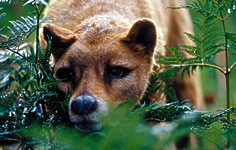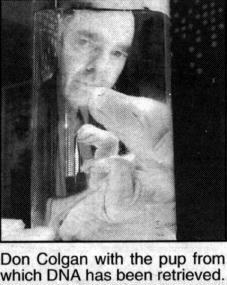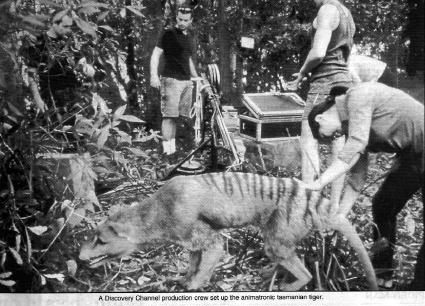
What have we actually done here, you've got an old Tasmanian Tiger (Thylacine) that was in a bottle?
We've got a pickled pup, that was the beginning, that was the first things we talked about, that was a wonderful thing, it was pickled in 1866 by George Masters in Tasmania, that wonderful man sent us a time capsule, all the way into the future with the perfect preserved DNA
You got the DNA from there?
We've announced two things today, which have been, making us very excited, the first is we've discovered the two additional specimens in the Australian Museum collections have viable good quality DNA. The problem with that little pickled pup, (she's a beautiful little girl) but hey, she's one little girl, she needs a little boy, we had to get male DNA from somewhere.
And if we were going to anticipate a viable population we'd need a variation, that's why this first announcement was so important about, Clearly we were going to get DNA from more than one individual, we now have it from three, theoretically from many more.It all depends on how hard we work and how much recoverable DNA is there.
We already know you can clone animals, we have seen cloned cats, sheep, cows. we know you can do it, now you have the DNA what is the next step?
The miracle of this project is not just that its cloning an animal, its big DNA, were, pulling back ancient things here.
You've got the DNA for the Tiger, what next?
Okay the next thing we had to know, is the DNA of sufficient quality there would actually be able for us to actually proceed with this project, this is an important keyhole we had to get through
Geneticists at the Australian Museum Drs. Don Colgan and Karen Firestone have ben breaking their necks to get a process called PCR to work on this DNA, and this is about Molecular cloning, if this works they can get massive amounts of the DNA and we can proceed with the other steps of the project towards the cloning project, that had to happen, we had to know the PCR would work and that's the second part of the announcement.
I can tell you what there was champagne corks popping and balloons everywhere. Because it works, the DNA is not dead its living DNA.
Okay what's next?
Okay, next we are going to start to massively reproduce all of the bits of the DNA, were headed for creation of a genetic library so we will get all of the Thylacine up and tagged onto a very friendly little bacterium or yeast who will hold it for us and replicate it for us as live DNA. And that will lead us forward in to the process we will then peel away the bacterial DNA and just work with the Thylacine DNA, artificial chromosomes, that technique is already there. And move ourselves steadily forward towards the cloning project, but boy im simplifying what is going to be years and years of hard work, but what a project
In the end you have to plant the cell, a fertilised egg into what or where?
What we probably do then is take a cell of a her close relative, like the Tasmanian Devil, living still in Tasmania, and take the genetic information of that egg-cell from the Tasmanian devil and replace it with the DNA of the Thylacine, so that egg cell can only produce an animal who's going to be a product of the Thylcaine recipe, so only a Thylacine can come out the other end, then we would hope that mother Tasmanian devil, while she gives birth to a tiny little marsupial young, its not the birthing that's the problem, she's going to start to raise what's to her the ugliest devil she's ever seen to her with stripes, and that's the way that project will probably proceed. But there's allot of work on the way
When might we see one Mike?
Oh mate, if I could tell you that, I just hope that im going to be still be frisky and excited when I get to pat those animals. There is a debate tomorrow night at the Australian Museum 6.30-7.00.
And the debate is about weather to clone or not to clone. There is allot of people, well not a lot, but a diminishing number, who think we shouldn't do it if we could, but there is a lot who think we should, and its going to be a vigorous debate, lots of interesting people coming from everywhere, some of the worst critics we have are coming up from Tasmanian to give us a canning. Robin Williams is sort of comparing the debate. If you want to have your say roll up.
From A 2GB radio Interview with Mike Archer from the Australian Museum.
An
Interview With Prof Mike Archer From The Australian Museum.
How did you get involved in this project? What started you on the road to such an amazing endeavor?
I have always been
interested in extinct species, having become obsessed with fossils when I was
11 years old. But in this case, there was a triple induction. After I returned
to Australia in 1967, I began a PhD on Australia's carnivorous marsupials and
in that arena, the Tasmanian Tiger is the supreme flesh-eater about which we
knew the least. It was an animal of almost total mystery. The third reason was
my excitement when I first realised
there was a 'pickled pup' in the collections of the Australian Museum. That
started me thinking nearly 15 years ago about the 'unthinkable' - the potential
of using its DNA to bring it back, before there were Dollys, cloned human insulin
and other things to suggest it was other than a mad dream.
What makes this project different from all other cloning projects?
There are many things that make this project different. First, it focuses on a fascinating but only recently extinct marsupial. Second, it sets out to redress our immoral actions when we wilfully and wrongly exterminated this animal. Third, it faces so many technological challenges that the science of this project will immediately be up front in a whole range of new and exciting areas.
What stage are you currently at in your attempts to clone the Tasmanian Tiger?
Having found DNA and isolated it (no easy tasks that some told us would be impossible), we are now engaged in efforts to replicate and sequence sections of the genome in anticipation of creating a genetic library of Tasmanian Tiger DNA. This is another big challenge, but one we have already begun to have success with!
What has been the most extraordinary discovery made through your work on this project?
That's a trick question because we have been working on two fronts. On the one hand, we have been searching for and finding 25-12 million-year-old ancestral Tasmanian Tigers from the stratigraphic sequence of World Heritage fossil deposits of Riversleigh in northwestern Queensland - very exciting stuff with more than seven different kinds having been found and named already!
Second, of course, our geneticists Drs. Don Colgan and Karen
Firestone have been pushing the frontiers of research with non-modern DNA -
and every new breakthrough in this field brings us just that much closer to
what could eventually be a technological
miracle.
What are the scientific implications of the discoveries you have made through this research?
Well, already we've overcome obstacles that critics tossed up in front of us, saying these couldn't be overcome. That simple fact has much broader implications in terms of the attitudes scientists have when challenged to do something that has never been done before. Some step out in front and lead even if they're not sure it will work; others for whatever reason hang behind and too often criticise those who try to lead.
I have never been particularly good at taking advice from people too quick to tell me what we can't do -particularly if no one has ever tried. I often wonder why centuries of egg on faces hasn't taught us greater caution about making declarations about what is 'impossible.
' Lord Kelvin, a noted scientist in his own right, declared in 1895 that there was no possibility that a heavier-than-air machine could fly - just a few years before the first plane roared overhead. Dolly too was an 'impossibility' that refused to stay impossible. The Tasmanian Tiger Project has already been adding more examples of this kind, and it is pleasing to see that several early critics of the project are now less critical and more interested in the possibilities.
That said, however,
it is important to realize that we know we may not
succeed. Yet, however far we get, we know we will have produced exciting new
science and left more solid bricks on a foundation that can be built upon by
the next group that picks up this challenge.
What are the moral implications of cloning an extinct species as opposed to an existing species?
I'm not big on cosmic morality, believing it to be very much a personal and subjective matter, often culture-specific. But in this case, most people agree that the 'immoral' act' was extermination of the Tasmanian Tiger in the first place; to bring it back, if we can, would be to me a moral imperative aimed at undoing that black act. Most churches agree.
Even a poll run on the internet in the United States, a country traditionally conservative about things like genetic engineering, was highly supportive of the Tasmanian Tiger Project with more than 75 percent of respondents in favour. Some Biblical fundamentalists have accused us of 'playing God,' a view which I reject utterly for the reasons just noted.
In contrast, other more mainstream theists draw attention to the fact that the teachings of Jesus are about giving life, not taking it away. There are even Biblical comments that could be cited as encouragement for this project such as The last enemy that shall be destroyed is death (New Testament, 1 Corinthians, Chapter 15, verse 26).
What will the social impact be in bringing the Tasmanian Tiger back to life?
For the Tasmanian Tiger's social life (because if we can bring back one, we can bring back a population – there are other specimens), it will be one heck of a stimulus!
But what social impact will it have on us?
Enormous I would have thought. To name just a few, tourism to Tasmania would massively increase, if the project against all odds is successful and Tasmania is where Tasmanian Tigers are re-established. To actually reverse extinction, even if it is in just this one special instance, would be the biological equivalent of the first walk on the moon – something thought to be way beyond dreams.
And, like the moon walk, it would do extraordinary things to kids' brains. They will be far more inclined to look beyond present limits, beyond prohibitions, to dare to try things that may result in equally awesome leaps in human capacity.
What did you think of the animatronic Tasmanian Tiger featured in the film?
I want one – until the real thing can make a reappearance!
There is controversy about whether or not the Tasmanian Tiger is still alive. How do you feel about this?
Sadly unconvinced. Without a single hair, dropping or any tangible evidence, I have to remain skeptical. Sightings, which most of the evidence is based on, are personal experiences and can't be put to the test. But I have met many very bright and genuine believers such as Col Bailey who has researched hundreds of sightings.
He almost had me convinced when we went wandering together through the bush where they were once known to abound. It's not hard to imagine one is watching you as you walk. And no one would be happier than me to be proved wrong and Col (Bailey) right - it would be fantastic!
But until someone
can produce the incontrovertible material evidence, I feel a moral obligation
to keep our Tasmanian Tiger Project on the rails. Let's see who comes up with
one first; it matters little to me who succeeds so long as in my lifetime, these
beautiful marsupials are once again back in the world - and I can see
one!
Taken From the Australian Museum Website
News Release
May 28, 2002
TASMANIAN TIGER CLONING BREAKTHROUGH
By Peter Firminger Press Release Australian Museum Tuesday, 28 May, 2002
After
more than twoyears of ongoing cloning research, the
Australian Museum has overcome a crucial obstacle in its continuing efforts
to bring back to life the extinct Tasmanian Tiger.

In May 2002 the Evolutionary Biology Unit at the Australian Museum in Sydney successfully replicated individual Tasmanian Tiger genes using a process known as PCR (Polymerase Chain Reaction). These new discoveries and the story of the Museum’s ongoing efforts have been exclusively documented by the Discovery Channel in The End of Extinction: Cloning the Tasmanian Tiger, premiering in 155 countries world-wide, including Australia, on July 7 at 7.30pm.
This remarkable journey which hopes to turn science fiction into science fact began in 1999 when the Australian Museum embarked on a never-before-attempted project to bring back an extinct species.
The last known Tasmanian
Tiger, or Thylacine, died in captivity in 1936, but a team of biologists believe
the
animal’s extinction may simply be a 70-year hiccup.
In 1999 DNA was successfully extracted from an ethanol preserved Tasmanian Tiger pup sample. Additional DNA has been extracted from two other individual pups in 2001. These other tissue sources included bone, tooth, bone marrow and dried muscle.

The most significant breakthrough to date has been the replication of individual Tasmanian Tiger genes using the PCR process. These PCRs show that short fragments of the DNA are undamaged and undoubtedly Tasmanian Tiger DNA, and that there is no reason why these should not work in a living cell.
"The Australian Museum is absolutely delighted with yet another major breakthrough in the cloning project,” said Professor Mike Archer, Director of the Australian Museum. "This technique was an extremely critical step in producing sufficient amounts of Tasmanian Tiger DNA to proceed with the research and extremely good news for future steps in accomplishing this project.”
The next stage is to make large quantity copies of all the genes of the Tasmanian Tiger so these can be used to construct synthetic chromosomes.
"What Professor Mike Archer and his team are attempting is as scientifically exciting and technically challenging as splitting the atom or landing a man on the moon,” said Maurice Paleau, Discovery Channel’s Executive Producer for the film. "We are excited to capture this amazing story, bringing the Tasmanian Tiger back to life on television screens around the world.”
The groundbreaking Discovery Channel film traces the remarkable efforts of scientists at the Australian Museum and features never-before-seen footage of a Tasmanian Tiger as well as state-of-the-art computer generated imagery (CGI) and animatronic technology. The film also includes exclusive behind-the-scenes footage of the extraction of Tasmanian Tiger tissue, the processing of the DNA and the next steps of the genetic engineering which could make cloning the Thylacine a reality.
FOR
FURTHER INFORMATION CONTACT:
Heidi DeWald, Australian Museum, (+612) 9320 6181 or
0419 376 736
Telegraph Environmental Reporter May/29th/2002
Simon Benson
It has been mocked as scientific fantasy, an impossible dream that will cost millions of dollars. Yet the project of bringing an extinct species back from the grave is moving ever closer to reality.
The Australian Museum yesterday announced a world-first breakthrough in its attempts to clone the Thylacine-the Tasmanian Tiger. The centre's geneticists claimed to have revived four Thylacine genes from the DNA of a preserved pup, replicated them and "bought them back to life". it is believed the DNA fragments actually contain thousands of copies of the complete set of the animal's 100,000 genes, which could be made to work in a living cell.
The extraction of four genes has proved that now it is possible to revive the entire Thylacine genetic code to make a complete living animal. Claiming a major obstacle to the project's success has been conquered, the team is confident it will be able to clone the animal-perhaps within 10 years.
This is the most advanced stage that any team has come to in attempts to clone an extinct species, they claim"The project has moved forward against all expectations Professor Mike Archer said. It means that the dead DNA extracted from the tissue of a preserved pup has been made to act in the same way as live DNA and millions of copies of the DNA have now been made. The DNA works."

"What we thought to be an impossible dream is now moving closer to reality. But we don't just want a strange animal pacing back and forth in a laboratory. We want to be able to reintroduce a viable population backing into the wild."
A further discovery has been made in the isolation of the DNA from at least two other specimens in the museum's collection. Now DNA is available from both a female and male specimen, offering hope that enough genetic material may be available from the many other preserved specimens around the world to produce a viable population. Professor Archer announced in 1999 that his evolutionary biology team, headed by Don Colgan, would embark on a plan to clone the Thylacine which was exterminated by humans by 1936.
In February this year a new technique used in the human genome project known as polymerase chain reaction-which employs an enzyme to break down DNA fragments and make copies of them- was used to revive the Thylacine DNA. This DNA will be used to create a genetic library of Thylacine DNA stored in bacteria which then could be decoded.
Synthetic chromosomes containing the genetic code then would be created to transfer into the cell of a surrogate mother ( A Tasmanian Devil would be a good chance) The Tasmanian Devil, a related species, has been identified as the most likely candidate for the task. The project is now the subject of a large scale Discovery Channel Documentary-to be aired in 155 countries on July 7-using spectacular animatronics technology to bring the Thylacine back to life on the screen. Picture below.
Yet the project still attracts its critics. Melbourne geneticist Professor Alan Trounsen described the team as "living in fairyland". Professor Archer said "I would certainly give any part of my anatomy to pat one of these animals in my lifetime."

End of Extinction
1936: Last known Thylacine (Tasmanian Tiger) dies in Hobart Zoo.
1999: Rheuben Griffiths Trust launched due to fund cloning research for the Thylacine.
2000: Australian Museum extracts DNA from the preserved Thylacine pup.
2002: DNA bough back to life.
2002-2004: Sequencing of the Thylacine genome to begin.
2004: Identification of suitable host expected.
2005-10: Attempts at fertilisation with host.
2010: Potential birth of first cloned Thylacine.